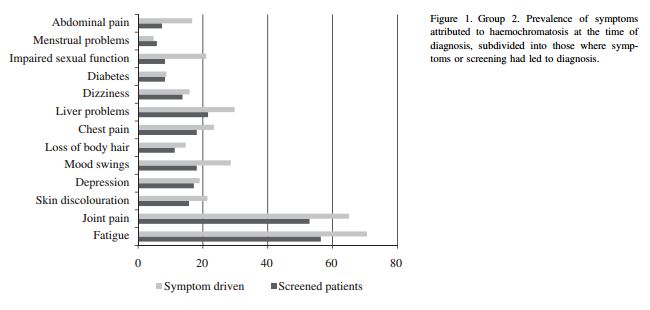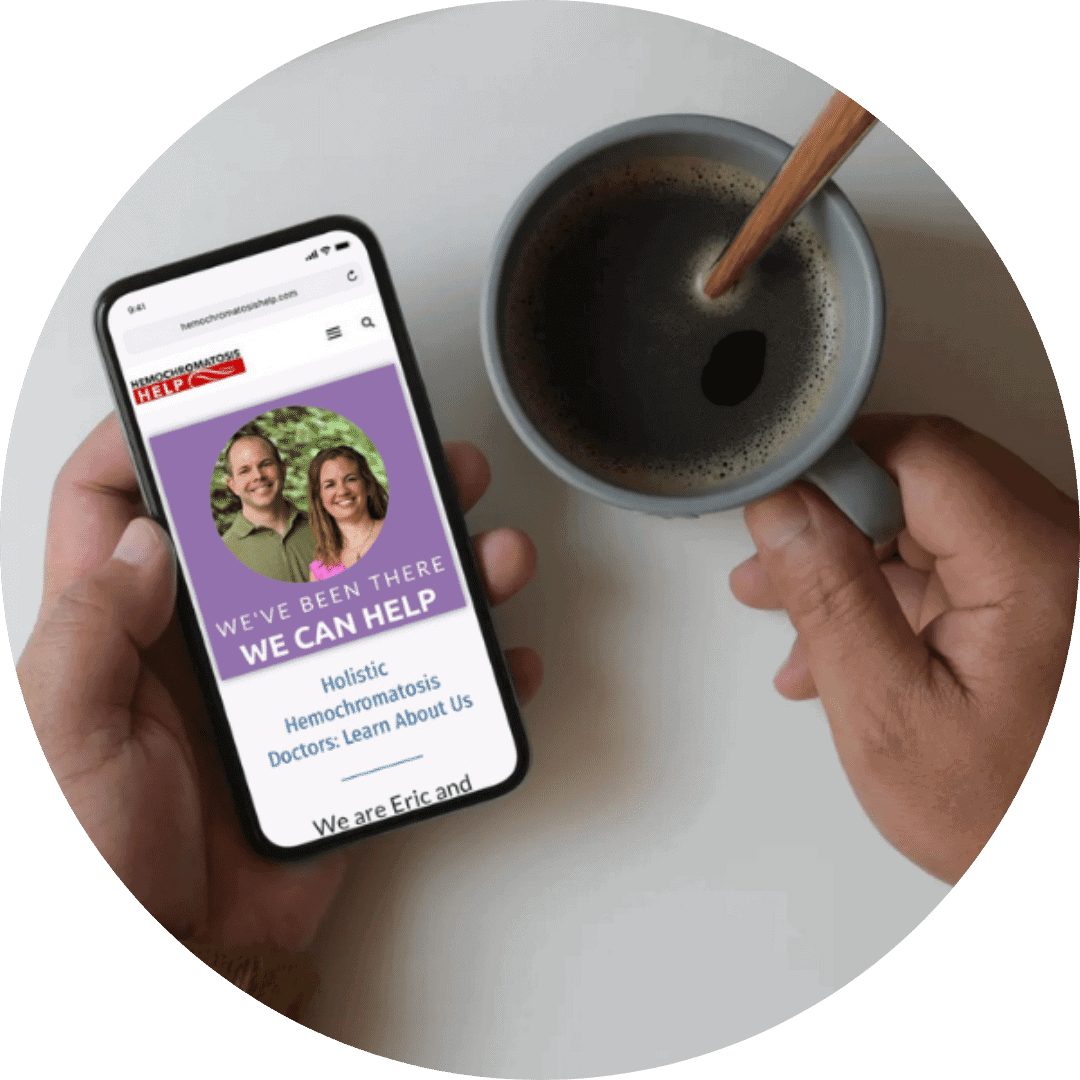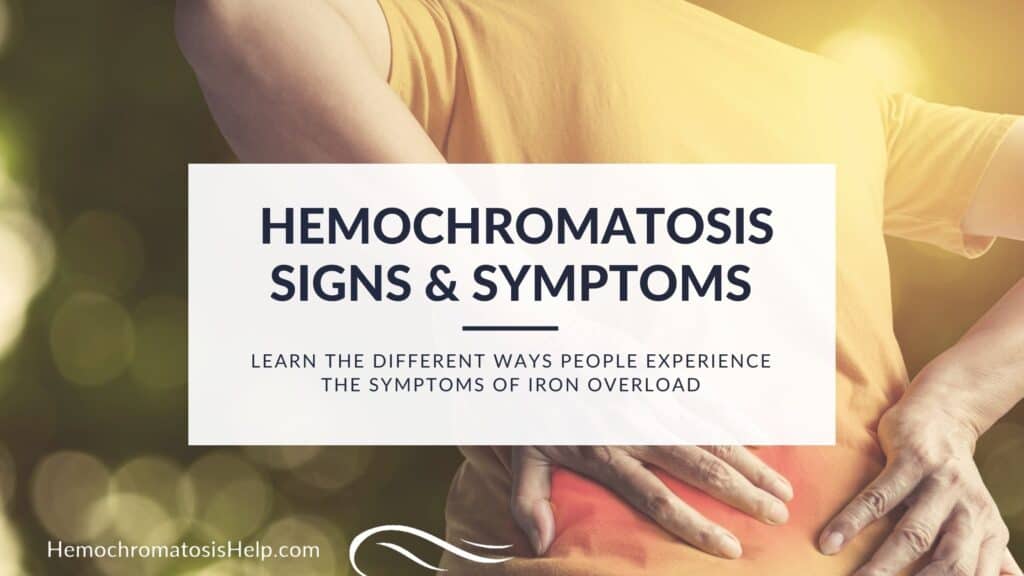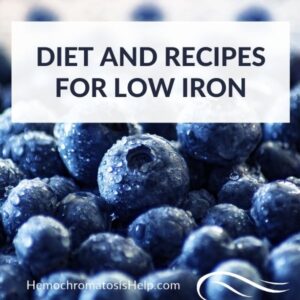Hemochromatosis Symptoms
A maddening aspect of too much iron is that no two individuals experience hemochromatosis symptoms in precisely the same way. In part, this explains why so many doctors fail to consider the signs of hemochromatosis when diagnosing a patient.
Most Common Iron Overload Symptoms
Iron overload can be tiring, painful, complex, confusing, and symptoms are often misunderstood. Symptoms of hemochromatosis range from mild to severe and can occur daily or periodically.
The two most prominent hemochromatosis symptoms are:
- Pain – Iron overload hurts. Nearly all individuals will experience some degree of joint, muscle, or body pain. This was my first clue when I first suspected I might have hemochromatosis. I began to have knee pain without any injuries or overuse. Both of my knees progressively became painful, stiff, and sore.
- Fatigue – Having too much iron is exhausting. Feeling less energy, being unable to enjoy or even complete daily activities, and waking unrefreshed in the morning are all frequently experienced hemochromatosis symptoms.
Serious Signs, Symptoms, and Complications of Hemochromatosis
Beyond the low energy and painful soreness, hemochromatosis carries a significant risk for long term health consequences. Iron absorption and accumulation builds over a lifetime and can lead to the following:
- Organ Damage– Iron overload can cause damage to internal organs, especially of the liver, pancreas, endocrine glands, cardiovascular system, and skin
- Liver Cirrhosis and Liver Cancer– The liver is the organ most at risk of damage from too much iron, with cirrhosis and cancer risk increasing in iron overload.
- Insulin Resistance and Diabetes– If the pancreas stores excess iron, an individual is at an increased risk of developing insulin resistance and, ultimately, diabetes.
- Bronze Diabetes– Bronze diabetes is a condition in which a person’s skin becomes bronzed from iron accumulation while they develop diabetes. Fortunately, bronze diabetes is less common with earlier diagnosis.
- Hypogonadism, Low Libido – When iron overload affects a man’s testes, he may experience a loss of testosterone along with a diminished libido
- Arthritis – Joint damage due to too much iron is most commonly seen in the knees, hands, and wrists. Read more about Hemochromatosis and Arthritis here.
Unchecked, severe cases of iron overload can and will progress through some, or all, of these serious signs, symptoms, and complications. Hemochromatosis can shorten life expectancy. It can be fatal. Fortunately, with early detection and treatment, these severe hemochromatosis symptoms may be entirely preventable.


FREE GUIDE: TOP 9 MISTAKES HEMOCHROMATOSIS PATIENTS MAKE
After working with hemochromatosis patients over the past 10 years we have seen these mistakes over and over again including:
- Why when your doctor says “phlebotomy is the only thing you can do” they may not be completely correct
- The real importance of diet and supplementation for those with hemochromatosis
- Why Googling about hemochromatosis is one of the last things we recommend
- And much more…
Less Serious Hemochromatosis Symptoms

Hemochromatosis symptoms can produce some less concerning, yet still undesirable consequences.
Patients, personal stories, and case studies also provide great insight into how this disease expresses itself symptomatically. Here are some other commonly reported symptoms of hemochromatosis:
- Restlessness, Difficulty Concentrating or Focusing
- Increased Sensitivity to Heat or Cold
- Sweating, Shallow Breathing, or Shortness of Breath
- Frequent Colds or Infections
- Inability to Relax Muscles, Back Pain
- Headache, Dizziness
- Skin conditions- including rash and itching
- Digestive Disturbances- Nausea, abdominal pain, constipation, or diarrhea may also be attributable to iron overload
Emotional and Psychological Symptoms and Challenges

Hemochromatosis can have a significant impact on our emotional and mental states. The following are some of the ways iron overload can affect our mental well being:
- Depression
- Inability to Relax
- Desire for Solitude
- Irritability and Anger
- Changeable Moods
Textbooks will often focus on the more physical signs and symptoms of hemochromatosis, such as pain, fatigue, arthritis, diabetes, and liver function.
While these symptoms of too much iron are widespread, I hear of the emotional impact of hemochromatosis as well.
Many people have shared with me their stories of how iron overload has affected them. Quite often, they tell me how taxed they feel mentally and emotionally.
Whether your symptoms of hemochromatosis are physical, mental, emotional, or all three, I always like to remind my readers that much can be done for iron overload.

Would you like to read hemochromatosis success stories? Learn more here.

Would you like to learn more ways to help your hemochromatosis? Join our newsletter.




